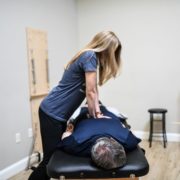Why Back Pain Keeps People from Exercising
Did you know that eighty percent of the population suffers from what we call “non-specific low back pain” (NSLBP)?
You might have NSLBP if your back pain:
- is often chronic
- comes out of nowhere
- comes and goes (you have good days and bad days)
- is not due to a recent or major accident or fall
If you’re reading this right now, odds are very good that YOU are one of the 80% suffering from NSLBP.
Did you also know that research says exercise is the BEST treatment for this type of back pain?
But what do you do if back pain keeps you from doing the one thing that is best for you??
We have an 8-week program designed to tackle this very important problem… but before I get into that, let’s go over some reasons why back pain keeps so many people like you from exercising.
1. FEAR
Back pain is scary! This is the number one reason back pain sufferers don’t exercise. Is the pain you’re feeling good or bad? Should you be feeling any pain at all? Pain is confusing. And when you experience pain during exercise, it can be difficult to know if it’s normal or a warning sign. For many, the safest thing to do is avoid any exercise or movement that causes pain. But doing this can lead to a host of other issues, namely, loss of mobility and in-activity. When you become less mobile and active, your back pain gets worse, and now you’re in a vicious cycle.
2. BULGING DISCS
Most people who suffer from long-standing NSLBP pain eventually find themselves getting an MRI. And 60-70% of the time, it will show one or more bulging discs. If you’ve been following me for a while, you already know that most people over the age of 40 walk around with bulging discs – and that 65% of them feel no pain at all! In other words, if you’ve got a bulging disc, you can’t be certain it’s the cause of your back pain. Research proves this. And being told you’ve got a bulging disc is NOT a reason to avoid exercise. Movement is actually one of the best things you can do for a bulging disc. It may require some customization of your current exercise routine, but a movement specialist can help you with this. Don’t just stop or avoid exercise altogether without talking to one first.
3. YOU WERE TOLD TO REST
Well-meaning doctors and family members who aren’t up to date on the latest back pain research will advise you to rest every time you experience back pain. This might be reasonable advice when you’re dealing with an acute episode of back pain, but it’s terrible advice for chronic back pain sufferers. Rest is one of the worst things someone with chronic back pain can do. Since most people don’t have a thorough understanding of this concept, they find themselves in a yo-yo effect. They rest to “heal” their back pain. When it’s gone they return to exercise. When they hurt their back again they stop and return to rest… I’ve seen so many people fall victim to this perpetuating cycle and it’s a big reason why so many back pain sufferers find themselves with the NEXT problem on this list…
4. YOU’VE GOT A “BAD BACK”
I can’t tell you how many times I’ve heard this one and it makes me want to scream! First off, there is no such thing as a “bad back”. There are backs with problems, and there are backs more sensitive to pain than others, but there is no reason to believe your back is inherently “bad” or that you should stop exercising. Not exercising causes almost all back problems to become worse, but it can also turn a “bad back” into a strong and healthy one! For most people, once you get the right guidance, you can quickly find yourself safely and confidently exercising again.
5. INEFFECTIVE CORE STRENGTHENING
Interestingly enough the research on this topic is quite scattered. Much of the research says that targeted core work doesn’t have any added benefit compared to general exercise when it comes to reducing back pain. What the research doesn’t tell you is that your core strength can make or break how well you exercise. If you don’t exercise with good proper form, you’ll end up with back pain. Learning how to properly strengthen your core has a HUGE impact on your ability to exercise in a way that will not cause your back to hurt. I meet a lot of folks who start doing “core exercises” to get their abs stronger and reduce back pain, but they end up hurting their backs instead. That’s because there is a right and a wrong way to properly strengthen your core, especially if you’re prone to back problems.
On Sunday, September 6th, we’re opening enrollment to our Pilates 101: Get [Your] Back to Health™ program.
You MUST apply to join this program.
Since this program fills up every time we offer it, we typically give the folks on our VIP waiting list an opportunity to sign up first.
Plus… when you sign up early, you can save up to $200 off the program!
If you’re suffering from NSLBP and you’ve stopped exercising, know that you’re not alone.
This is such a confusing topic and there are so many mixed messages out there about what the “right” and “wrong” thing to do is.
Don’t try to go at it alone!
Exercise is GOOD for your back, but you may just need a little help and guidance — and perhaps proper core strengthening — to get you there.



